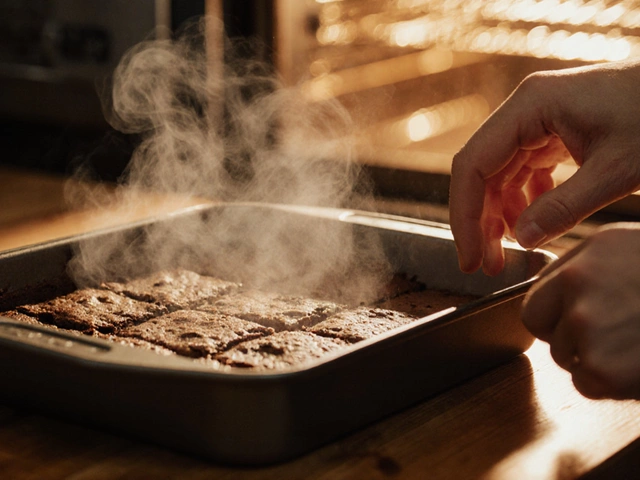Saying tiramisu is the world’s tastiest dessert might cause a stir, but if you’ve ever had that first bite—the soft layers, the hit of coffee, the creamy filling—you know it’s hard to argue. People rave about tiramisu because it balances sweet, bitter, and creamy in a way few other desserts pull off. Whether it’s a holiday treat or just a Thursday craving, tiramisu fits the bill without feeling too heavy or too sweet.
But what’s the real deal behind its popularity? It’s not just about taste; it’s also easy to make at home and doesn’t require baking. If your oven is your sworn enemy, tiramisu won’t judge. The only catch: fresh ingredients make a huge difference. A decent mascarpone, real espresso, and ladyfingers that actually soak things up—that’s where the magic happens.
- What Makes Tiramisu So Special?
- Where Did Tiramisu Come From?
- Classic Ingredients and How They Work Together
- Tips for Making Perfect Tiramisu at Home
- Common Mistakes (and How to Dodge Them)
- Unusual Tiramisu Variations Worth Trying
What Makes Tiramisu So Special?
So, what pushes tiramisu to the top of a dessert list? For starters, it's that combo of flavors you can’t really fake: rich coffee, a little cocoa, fluffy mascarpone, and soft, but not mushy, ladyfingers. Tiramisu isn’t overly sweet, which says a lot when most desserts almost give you a sugar rush. It’s all about balance, and that's what keeps fans coming back for more.
One really cool thing is that tiramisu is a natural mood-booster. Thanks to the espresso and cocoa, you get a tiny caffeine kick—a slice typically holds as much as 30 mg of caffeine! That’s about a third of an espresso shot, so you won’t be bouncing off the walls, but it’s not nothing.
The texture is another reason tiramisu stands out. You bite in, and there’s a softness that just melts in your mouth, but you also get a slight crunch from the cocoa dusting on top. There aren’t many no-bake desserts that nail this contrast.
- Tiramisu is super versatile—it goes casual or fancy, depending on how you serve it.
- People with egg allergies or dietary needs often tweak the recipe and it still works. Vegan, gluten-free, even alcohol-free versions keep popping up everywhere.
- Leftovers? Tiramisu actually gets better after chilling for a day or two. The flavors sink in, so every bite is even smoother and richer.
| Key Element | Why It Matters |
|---|---|
| Mascarpone | Gives tiramisu its creamy flavor and smooth texture |
| Espresso | Adds depth and a gentle caffeine kick |
| Ladyfingers | Soak up coffee without turning to mush |
| Cocoa Powder | Brings a hint of bitterness to balance the creaminess |
Add to that the fact that tiramisu is easy to slice, simple for crowds, and you don’t need a pastry degree to whip it up—these are the details that make it a real legend in the dessert world.
Where Did Tiramisu Come From?
This might surprise you: tiramisu isn’t as ancient as you’d expect. While some Italian desserts trace back centuries, tiramisu popped up only in the 1960s. It started in the Veneto region in northern Italy. Most stories point straight to a restaurant in Treviso, called Le Beccherie, as the first place to put *tiramisu* on the menu. It’s a little controversial because a few other places nearby claim they came up with it, too, but Treviso gets the most credit.
The word 'tiramisu' means “pick me up” in Italian. It makes sense if you look at what goes in—a jolt of strong coffee, a bit of cocoa, a creamy layer, and sometimes even a splash of liqueur. This combo was meant to give you a boost, whether you needed help waking up or just wanted something sweet after a meal.
What’s also wild is how quickly tiramisu went global. In just a few decades, you could find it everywhere, from tiny Italian bakeries to big chain restaurants, and now, all over the world. Despite the hype, the core of tiramisu hasn’t really changed: it’s all about simple ingredients layered just right.
So next time you dig into a slice, you can say you’re enjoying a modern classic, not some long-lost ancient treat. That’s part of what makes tiramisu so cool—it's familiar, easy to make, and just new enough to start a tiny argument at any Italian family dinner.
Classic Ingredients and How They Work Together
If you break down tiramisu, there’s nothing random in there. Every ingredient plays a role and skipping even one changes the whole vibe. So, what actually goes in?
- Tiramisu uses ladyfingers—those spongy biscuit sticks that soak up coffee without turning to total mush. They’re basically the backbone.
- Espresso brings a shot of rich, deep flavor. It’s strong enough to cut through the sweetness and gives every bite that wake-up kick.
- Mascarpone cheese is what makes tiramisu creamy. Think of it like cream cheese’s mellow, silky cousin. It’s what gives tiramisu its velvety filling.
- Egg yolks and sugar go together to create that thick custard layer. Some people skip the eggs for safety, but classic recipes swear by them for texture.
- Cocoa powder adds a hit of bitterness on top, so every spoonful starts and ends with a punch.
It might look simple, but the magic is how these work together. Ladyfingers act like sponges, holding up the moist, coffee flavor. Mascarpone and egg yolks make things extra rich and creamy. The cocoa powder keeps the dessert from getting too sweet. You can swap in coffee liqueur (like Kahlúa or Marsala wine) if you want to play with extra flavor, but you don’t need much—just a couple tablespoons does the trick.
| Ingredient | Role | Notes |
|---|---|---|
| Ladyfingers | Structure & texture | Best when quickly dipped |
| Espresso | Flavor | Strong, fresh-brewed for max taste |
| Mascarpone | Creaminess | Don’t swap for cream cheese if you want the real deal |
| Egg yolks | Body & richness | Use very fresh eggs or pasteurized for safety |
| Sugar | Sweetness | Mix with yolks—don’t overdo it |
| Cocoa powder | Finishing flavor | Unsweetened for contrast |
So next time you wonder why homemade tiramisu never feels quite like the one from that little Italian café, check your ingredients. The right stuff, in the right amounts, is everything.

Tips for Making Perfect Tiramisu at Home
Tiramisu might look fancy, but you don’t need to be a pro chef to get it right at home. There are a few spots where people slip up, but if you stick to a few straightforward tips, your tiramisu will taste just like the classic Italian dessert you crave.
- Start with fresh mascarpone. That creamy cheese is the heart of the dessert. Stale or cheap mascarpone turns gritty and ruins the texture.
- Use real espresso. Skip the instant stuff if you can. Strong, fresh espresso gives the dessert its proper punch and keeps it from tasting bland.
- Chill your mixing bowl. When you whip the cream, a cold bowl makes it fluffier and helps everything mix together nicely.
- Don’t over-soak ladyfingers. Dunk them quickly—about 1-2 seconds—so they absorb flavor without turning to mush.
- Layer it right. Spread a thin layer of mascarpone mix first, then ladyfingers, then repeat. You want clean, even layers so every bite has a bit of everything.
- Let it rest. Tiramisu tastes way better after a night in the fridge (at least 6-8 hours). This gives the flavors time to blend.
Here’s a quick data snapshot on what most people agree makes or breaks a tiramisu:
| Factor | Must-Have? | Why It Matters |
|---|---|---|
| Fresh mascarpone | Yes | Creaminess and the right taste |
| Real espresso | Yes | Gives punch and classic flavor |
| No-bake preparation | Yes | Keeps texture light and authentic |
| Dusting of cocoa | Yes | Adds bitterness and looks great |
| Alcohol (Marsala/coffee liqueur) | Optional | Kicks up the flavor but not required |
If you want to get creative, you can add a bit of Marsala wine or coffee liqueur to the coffee for dipping. Just go easy—too much, and you’ll overpower the dessert. Stick to these basics and you’ll find tiramisu is way less intimidating (and way more delicious) than it seems.
Common Mistakes (and How to Dodge Them)
If your tiramisu tastes off, falls apart, or looks sad, you’re not alone—these are classic mess-ups that almost everyone faces sooner or later. Let’s get real about what usually goes wrong and how you can actually fix it next time around. The goal here: a tiramisu you can brag about.
- Tiramisu turns soggy: The most common complaint is mushy layers. Ladyfingers need just a super quick dip in coffee—think 1-2 seconds tops. They should feel soaked, but not dripping. Overdo it and you get sad pudding, not dessert.
- Using cold mascarpone straight from the fridge: This messes up your cream’s texture. For a silky filling, bring mascarpone to room temperature first. It blends way better and gives you that classic smooth mouthfeel.
- Raw eggs vs. pasteurized: Recipes that call for raw eggs freak some people out, and for good reason. If you’re worried, look for pasteurized eggs, or cook them gently with sugar over a double boiler. Safety matters and you still get a great texture.
- Skimping on the coffee (or using weak coffee): Tiramisu is famous for its coffee punch. Brew strong espresso or a concentrated coffee. Weak coffee makes every layer bland.
- Making it and eating right away: This is a patience test. The flavors need at least 6 hours in the fridge to meld. Even better if you can hold off overnight. Fresh is not best here.
- Wrong kind of ladyfingers: Some brands just go to mush. Look for dried, crisp Italian savoiardi—these stand up to the soak way better.
Here’s a quick table showing how even small tweaks make a difference:
| Mistake | What Happens | How to Fix |
|---|---|---|
| Over-soaked ladyfingers | Dessert turns soggy | Dip just 1-2 secs in coffee |
| Cold mascarpone | Grainy, lumpy cream | Let mascarpone sit out until room temp |
| Weak coffee | Blah flavor | Use strong espresso or double-strength coffee |
| Eating too soon | Flavors taste flat | Chill at least 6 hours, overnight if you can |
Stay mindful of these slip-ups, and making tiramisu becomes a breeze. Even if you mess up once or twice, the fixes are totally doable and make a big difference for the final bite.
Unusual Tiramisu Variations Worth Trying
The classic tiramisu is already a crowd-pleaser, but playing around with new flavors never hurts. In recent years, cafes in cities like Tokyo and London have turned tiramisu into a creative playground. Let’s look at a few twists you can actually make at home or try if you’re lucky enough to spot them on a menu.
- Fruit Tiramisu: Swapping out the coffee for pureed berries or mango sets a whole new vibe. Strawberry tiramisu is a summer hit in Italy—just soak ladyfingers in sweet berry juice instead of coffee. Top with fresh fruit for extra flavor.
- Matcha Tiramisu: In Japan, matcha powder often replaces cocoa, and the coffee layer gets swapped for green tea. The matcha brings a slightly earthy, less sweet profile. You’ll spot this in Instagram posts from trendy cafes in Osaka and Kyoto.
- Chocolate Tiramisu: For die-hard chocoholics, cocoa isn’t always enough. Some layer chocolate ganache or use chocolate cake instead of ladyfingers. The result is richer and a lot more decadent.
- Lemon or Limoncello Tiramisu: This sunny twist uses lemon zest and a dash of Limoncello for a sharp, zingy flavor. It’s become popular along Italy’s Amalfi Coast in the summer months.
- Alcohol-Free Tiramisu: Many families skip the booze so kids can join in. They might use orange juice, coffee alternatives, or even malted chocolate drinks instead of Marsala or Kahlua.
For a sense of what’s trending, check this quick table about the most popular tiramisu spins based on international food magazine polls in 2024:
| Variation | Popularity (Percent) | Main Swaps |
|---|---|---|
| Fruit Tiramisu | 34% | Berries, mango instead of coffee |
| Matcha Tiramisu | 27% | Matcha tea for coffee/cocoa |
| Chocolate Tiramisu | 24% | Chocolate cake, ganache |
| Limoncello Tiramisu | 11% | Limoncello, lemon zest |
| Alcohol-Free | 4% | Juice or malted drinks |
Switching up tiramisu like this keeps the dessert interesting, even for lifelong fans. So next time you’re wanting something sweet, don’t feel stuck with just the basic recipe—try one of these variations for a totally new take.





